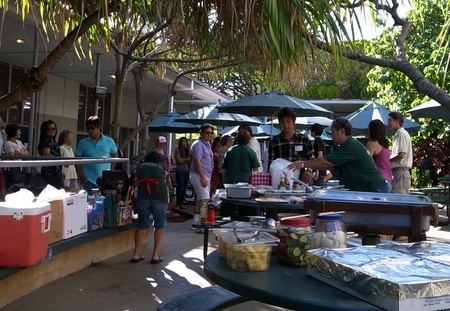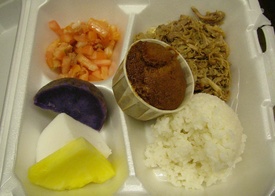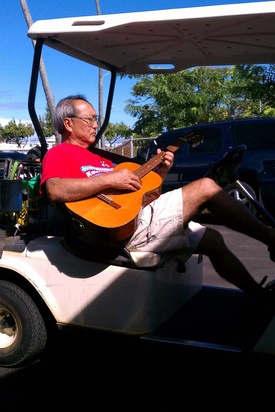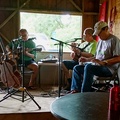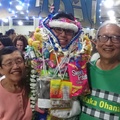There is a private junior and senior high school called Mid-Pacific Institute on the north side of the University of Hawaii's Manoa campus. It is an elite school in Honolulu, on a par with Punahou and Iolani. It is abbreviated as MPI, so one of the graduates joked that M(id-Pacific Institute) is at the forefront, with P(unahou) and I(olani) following behind.
The school is fully equipped with dormitories, and students come from the Hawaiian islands. There are many Japanese-Americans enrolled and graduated. There is also an English language training program, and the school accepts not only students but also groups of adult trainees.
Mr. L and his older and younger brothers are also graduates here.
About 20 adult language trainees from Japan were coming to MPI, and Ms. M and L were tasked with serving them lunch. As I wrote before, Ms. M was the executive chef of a famous hotel in Waikiki before moving to become an elementary school cafeteria manager. Ms. L was an elementary school teacher before becoming an elementary school cafeteria manager. After retiring, Ms. M and L occasionally get requests like this. I also helped out with meal service at funerals and at the city hall (just preparing the equipment and plating the rice), and seeing everyone's satisfied smiles gave me a joy I had never felt in my life before.
When I was to serve lunch, I was staying at M-san and L-san's house. They told me, "You have to get up at 3 o'clock tomorrow," so I went to sleep, wondering what was going on. At 4 o'clock, we loaded a mountain of luggage onto the back of a truck and left Kaneohe for Honolulu.
At 4:30, we arrived at the home of Mr. F, a Japanese-American living in a residential area southeast of the University of Hawaii. Mr. F is also a graduate of MPI and a classmate of Mr. L. Japanese students from the University of Hawaii often stay in the annex on the premises. There is a covered courtyard that is somewhat reminiscent of a Japanese earthen floor, and Japanese students attending language training gather there in the afternoon.
We carried in burners, huge frying pans, a huge number of cooking tools, dining utensils, and mountains of food. After that, the three of us went to the New Otani Hotel on Kaimana Beach at the edge of Waikiki and had breakfast with Hawaiian masters Eddie Kamae and Myrna Kamae. I ordered the specialty Eggs Benedict at the Hau Tree Lanai restaurant, and everyone laughed at me. At that time, I was still doing the same things as Japanese tourists.
We parted ways with the Kamaes just after 8 o'clock and returned to Mr. F's house. We set up a burner under the blue sky at the edge of the courtyard and started grilling steaks from around 11 o'clock. We were able to see the former executive chef's techniques, such as how to grill the most delicious steak, the difference between rare and medium, how to drain the juices, how to check if the steak is done, how to sprinkle salt and pepper, and how to cut the steak. The Japanese people, regardless of age, gobbled down the steaks and continued to squeal with delight at how delicious they were. Of course they were. The meat was grilled by the former executive chef. Although I was the one who turned the steaks over.
During this time, I was supporting M-san and had no time to talk or eat with the language trainees from Japan. When they were leaving, they thanked me so politely that I felt embarrassed. Together with M-san and L-san, I waved goodbye with a smile on my face.
The day after the barbecue is Respect for the Aged Day.
I was invited to the Ala Moana Hotel with M, L, F and others as a thank you for the barbecue. In the event room, there were a number of performances for Japanese-American seniors on Respect for the Aged Day. We all enjoyed them while eating lunch. The language students from Japan also did a skit. It was a spontaneous performance as part of their language training.
The trainees had been practicing before they left Japan, and had put a lot of thought into their costumes. The theme song was "Mito Komon," and after they sang the theme song, when they got to the part where they said, "Can't you see this crest?..." and "Haha...", the hall was sure to erupt in thunderous applause. I think the trainees thought the same. But I held my head and closed my eyes as hard as I could.
The entire venue was enveloped in a quiet, warm, and considerate atmosphere. The trainees' plan had completely failed.
Although KIKU, a Japanese TV station in Hawaii, buys many programs from TBS in Japan and broadcasts them, they have never broadcast Mito Komon. Therefore, a program that boasts such high viewer ratings in Japan was completely unknown in Hawaii (at the time).
I couldn't stand it any longer, so I called out to the three women playing Sukesan, Katsusan, and Lady Mito. "You were very good! But Mito Komon isn't broadcast here, so no one knows it. So there's nothing to be worried about."
Then, the three of them's faces changed to expressions of surprise in an instant. "Wow! Your Japanese is so good! There's no accent at all, it's beautiful Japanese! Where did you learn it?" they complimented. It was a typical Japanese response. Then I realized right away. At the barbecue the day before, I was devoted to supporting M-san, so I didn't interact with the trainees. That's why they thought I was a Japanese person in Hawaii.
``Thank you so much for grilling delicious steaks for Mom and Dad yesterday!'' She was mistaking Mr. M and Mr. L for my parents.
At times like these, I sometimes find myself joking around.
Me: "I've never been to Japan, and I'm sure everyone rushes onto the trains, right? Isn't it dangerous to rush onto a crowded train? There are no trains in Hawaii, so I don't know much about it..."
When Japanese people hear about misconceptions about Japan, they suddenly become kind. "Hey, hey! Come to Japan sometime! I'll show you around Tokyo and Kyoto. There are a lot of trains running like spaghetti, and there are a lot of subways."
Me: "You don't buy tickets anymore in Japan, do you? You can go through the gates just by putting your hand on them, right?" I joked further. "Oh, that's Suica or Pasmo! You pay with money first. You buy a card for 500 yen and add some money to it. Please come next time!"
Me: "But, you know, I hate natto..." When talking about uniquely Japanese foods, Japanese people get increasingly talkative. "There's a lot of natto that doesn't have a smell. If you go to Mito and try the real thing, you'll like it!" I was about to continue when I couldn't hold myself back any longer.
"Actually... I'm Japanese," I replied, and the girls seemed to come back to their senses. "I teach at Tokyo Gakugei University, and I come to Hawaii several times a year for research."
When I got to that point, the girls shouted, "A professor from Gakugei University?!" and stood still. They then bowed their heads. M-san, L-san, F-san and others who were watching burst out laughing. I know how Japanese people laugh when they see a Japanese person standing still. But I hate that kind of standing still. It's not like university professors are particularly important.
Without fear of sounding like a stereotype, Japanese people feel uneasy in their relationships unless they are clear about the other person's age and occupation. This is because it is an important factor that determines the emotional distance and how to speak to them.
It is often said that immigrants are the carriers of culture. Even today, when the sixth generation of Japanese immigrants are being born, Japanese people in Hawaii carefully preserve their Japanese culture, to varying degrees. However, in friendships, what a person's occupation is of little importance. It is not uncommon for people to not know what their close friends do. They interact with people based on who they are, rather than what their status is.
There is no discrimination based on social status. M-san and L-san are typical examples. This makes it easy for people meeting for the first time, and it also supports people like me who came from Japan and want to build long-term relationships. However, it goes without saying that the evaluation of "who" is harsh.
In fact, M-san has a reputation for judging people. L-san often says the same thing. That's why I choose people when I take my friends or students out for the first time. The criterion is not whether they like it or not. It's whether they try to speak English to M-san, who only understands a little Japanese. If they can't speak English, it's whether they try to speak to M-san, even if they have to ask me or L-san to translate. If they can do that, they can have fun by themselves at garage parties and other gatherings where our friends gather.
Recently, M said something similar. "The only people I invite to my parties are those who can entertain the people around them. They don't have to play or sing. I want them to have fun with the people around them, and while eating my food. It's the most painful thing to see them eating alone."
Japanese people in Hawaii are American in terms of their relationships with others.
© 2018 Seiji Kawasaki



